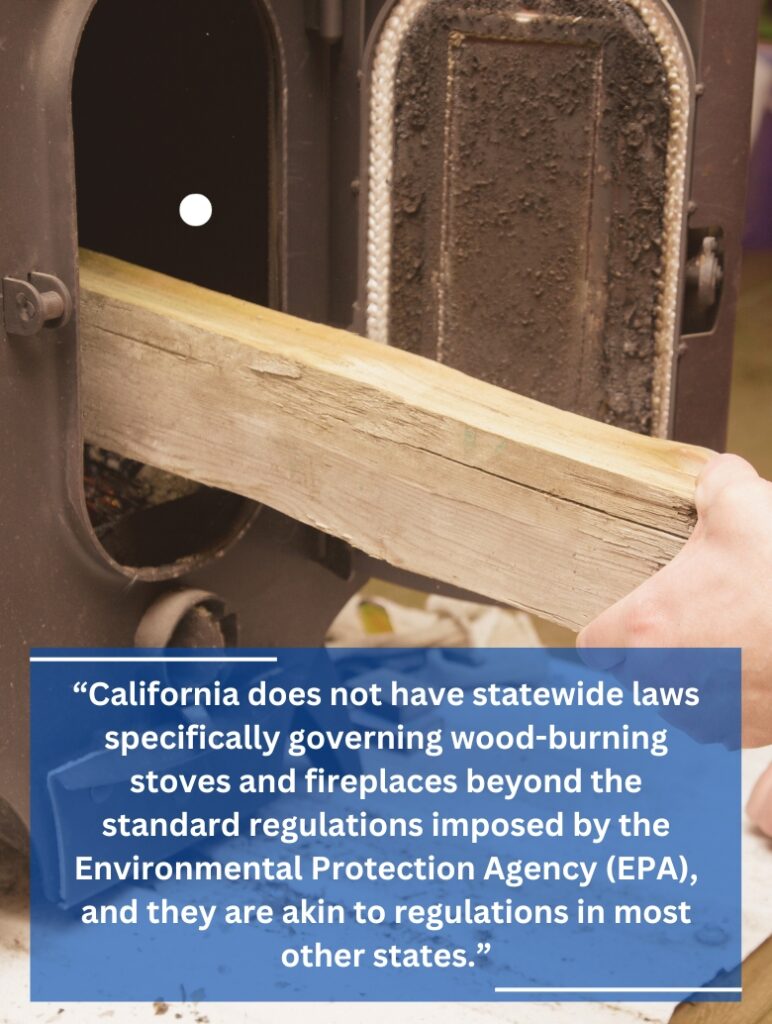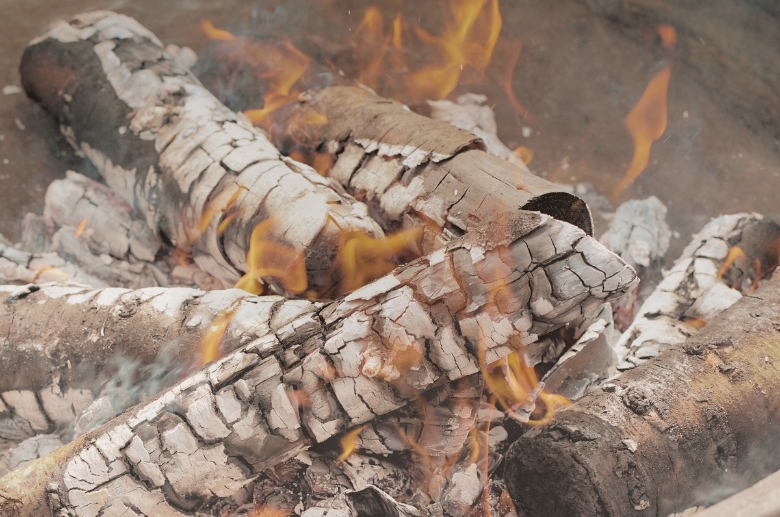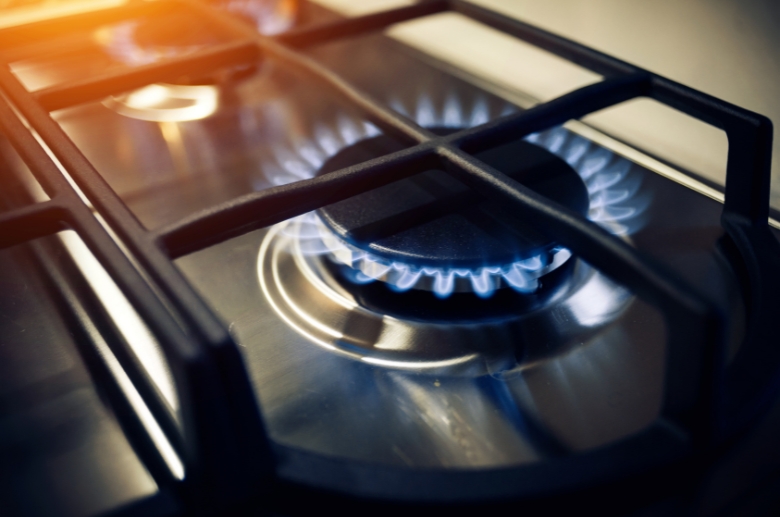There’s nothing quite like the cozy warmth and comforting crackle of a wood-burning fireplace. Yet, homeowners in California face an important question: Is it legal to burn wood in a fireplace in California?
As regulations and concerns about air quality continue to evolve, it’s essential to understand the laws and regulations surrounding wood burning in the Golden State.
This guide thoroughly examines the legality, environmental consequences, and potential alternatives to burning wood in Californian fireplaces.
Is It Legal to Burn Wood in a Fireplace in California?

California does not have statewide laws specifically governing wood-burning stoves and fireplaces beyond the standard regulations imposed by the Environmental Protection Agency (EPA), and they are akin to regulations in most other states.
However, different California municipalities may have specific regulations in place. You can find these municipal regulations on the Burn Wise program of the U.S EPA.
These regulations generally do not prohibit using wood-burning stoves and fireplaces when they are the sole available heat source. However, it’s crucial to note that permanent wood-burning devices are typically prohibited in new residential developments.
Furthermore, for homeowners with wood-burning fireplaces, mandatory “no-burn” days may be enforced during periods when high pollution levels are forecast.
The weight of particulate matter generated by a combustion device within an hour is measured to gauge compliance with EPA standards. It is considered environmentally unsound if this measurement exceeds 2.0 to 2.5 grams.
To put it into perspective, consider human hair with an average diameter of about 70 micrometers. This makes a single hair approximately 30 times larger than the largest fine particle, measuring 2.5 micrometers.
——
Do You Need to Hire Chimney & Fireplace Expert?
Get free quotes from qualified experts near you. No commitment required!
——
Current Laws and Regulations on Wood Burning in California
Wood burning in residential fireplaces in California is subject to a web of laws and regulations. These rules address air quality concerns, especially during the colder months when wood burning is prevalent.

For instance, Winter Spare the Air is a program that aims to reduce air pollution during the winter season in the Bay Area. Residents are prohibited from burning wood, manufactured fire logs, and other solid fuels, indoors and outdoors, when a Spare the Air Alert is in effect.
According to the updated regulations, individuals relying solely on a wood-burning device for heating must use a U.S. Environmental Protection Agency-certified or pellet-fueled device registered with the air district to qualify for an exemption.
Residents undertaking chimney or fireplace remodeling projects that exceed $15,000 and necessitate a building permit may only install a gas-fueled, electric, or EPA-certified device. No wood-burning devices, regardless of type, can be installed in newly constructed homes or buildings within the Bay Area.
Another key aspect is the limitation on wood burning during high-pollution days, which is crucial to maintaining breathable air for everyone. However, it’s essential to note that local ordinances and regulations might vary by city or county in California.
What’s allowed in one area may not be permissible in another. You can refer to this resource for further information.
The repercussions of disregarding wood-burning laws can be significant. Violations can result in penalties and fines, and it’s crucial to stay informed about your local regulations to avoid these legal consequences.
For instance, when an alert is issued, individuals violating the wood-burning rule for the first time can choose to attend a wood smoke awareness course or pay a $100 fine. For subsequent violations, the fines escalate, with second offenses incurring a $500 penalty and further violations resulting in increased fines.
It’s not just about legality; it’s also about fostering a cleaner environment and ensuring better air quality for everyone.
Exceptions and Exemptions to Wood Burning Laws in California
While wood-burning regulations aim to reduce air pollution, there are exemptions for certain types of wood stoves or fireplaces that meet specific emission standards.

Devices that are EPA-certified or low-emission wood stoves are usually compliant with these regulations, making them a more environmentally friendly option. To determine if your wood-burning device is EPA certified, consult your retailer or refer to the provided list of EPA Phase II certified wood-burning heaters.
Certain situations can warrant exemptions as well. For example, wood burning may be allowed during power outages when no alternative heating sources are available.
Additional exemptions encompass a financial hardship waiver (which must gain approval from the Air Pollution Control Officer and be renewed each burn season), devices operating solely on natural gas or propane, cooking appliances, and ceremonial fires linked to particular religious practices.
These exemptions are designed to provide flexibility while balancing heating needs and environmental concerns.
In some parts of California, “no-burn” areas have been designated to protect air quality, influencing decisions between gas vs wood burning fireplace installations. If you reside in such an area, you must be aware of specific regulations that might apply to your wood-burning fireplace.
Navigating the rules and exemptions can be complex, but ensuring you comply with the law is necessary. You can find it on California Fire Information and Fire Restrictions webpage.
Health and Environmental Impacts of Wood Burning in California
While a wood-burning fire can create a warm and inviting atmosphere, it also produces harmful byproducts.

Wood smoke contains fine particulate matter, which can enter your respiratory system and lead to health problems. Here are the individuals most affected:
- Children: Children are at greater risk from wood smoke due to their developing respiratory systems and higher air intake compared to adults. Exposure can trigger symptoms like coughing, wheezing, and breathlessness.
- Elderly: The elderly face heightened vulnerability to wood smoke effects, often having pre-existing respiratory or cardiovascular conditions. Wood smoke exposure can worsen these conditions, sometimes leading to hospitalization.
- People with respiratory conditions: Individuals with conditions like asthma or chronic respiratory diseases are especially susceptible to wood smoke’s harmful impacts, which can worsen their symptoms and overall health.
- People with cardiovascular disease: Those with heart diseases are more prone to wood smoke effects, which can exacerbate their conditions and potentially lead to severe health issues.
- Low-income people: Low-income individuals are more likely to encounter wood smoke exposure, often due to limited access to cleaner heating options. In some cases, wood-burning homes in economically disadvantaged communities may not meet health standards.
——
Do You Need to Hire Chimney & Fireplace Expert?
Get free quotes from qualified experts near you. No commitment required!
——
Wood burning also contributes to air pollution, which is a significant concern for the environment. The fine particles in wood smoke, also known as fine particulate matter or PM2.5, can affect air quality. This pollution can contribute to climate change as well.
For instance, burning wood emits carbon dioxide and methane, potent greenhouse gases that play a substantial role in climate change. Furthermore, wood smoke contains black carbon, a climate pollutant known for its exceptional ability to absorb sunlight and convert it into heat.
Black carbon influences cloud formation, impacts regional rainfall patterns, and contributes to various aspects of climate change. After consequent fire incidents, California has been actively working to reduce its carbon footprint, and wood burning can counteract these efforts.
Alternatives to Wood Burning in California

Thankfully, cleaner and more sustainable heating alternatives are available in California. Natural gas, propane, electric, and pellet stoves are all excellent options that produce significantly less pollution than traditional wood-burning fireplaces.
For instance, these alternatives are 75 to 90% efficient compared to traditional wood-burning fireplaces, which are only 25% efficient. These alternatives offer better efficiency and contribute to a healthier environment.
California encourages residents to transition to cleaner heating alternatives by providing incentives and programs. For example, in San Joaquin Valley, if you replace your old wood- or pellet-burning device with a new, electric or natural gas option, you can get a financial incentive of up to $3,500.
These financial initiatives aim to make it more affordable and accessible for homeowners to adopt eco-friendly heating sources. It’s not only beneficial for your health and the environment but also for your pocket.
Homeowners Tips for cleaner burning:
If you’re committed to keeping your wood-burning fireplace, there are steps you can take to reduce the emissions and improve indoor air quality.
- Use seasoned wood: Seasoned wood produces fewer particulate emissions when burned compared to green wood. This means less pollution and a reduced impact on air quality.
- Invest in an EPA-certified wood stove: These specialized stoves are engineered for enhanced wood-burning efficiency, resulting in reduced smoke and emissions.
- Ensure proper installation, inspection, and maintenance of wood-burning equipment: Routine checks and maintenance not only enhance burning efficiency but also minimize the risk of fires.
- Avoid smoldering fires: Resist lowering the stove’s airflow to a minimum during the night to curb excess smoke.
- Seal off windows and doors as much as possible: This minimizes exposure to external sources of wood smoke.
- Maintain your home furnace for optimal operation and clean filters: A well-maintained furnace reduces the need for outside air circulation.
It’s important to note that wood burning can still produce harmful emissions even when these tips are followed. Therefore, avoiding burning wood altogether is best, especially during high-pollution days.
Conclusion
So, Is it legal to burn wood in a California fireplace? The answer depends on various factors like statewide regulations and local rules. But consider this: knowing the health and environmental effects is essential
Your wood-burning decision should be holistic, factoring in legality, home safety, community impact, and environmental concerns.
Remember, whether you embrace a traditional wood-burning fireplace, install a cleaner heating source, or explore other options, you play a part in shaping California’s air quality and environmental future.
Complying with the law, adopting sustainable heating methods, and prioritizing health is the path to a warmer, safer, and eco-friendly California.






